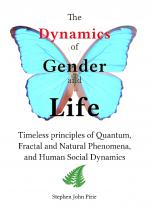[Excerpt Be and Become, © ProCreative, Sydney 2000]
With the assistance of the Table Of One and All (TOA), we can now begin to understand in deeper terms the ways in which gender roles have been allocated within our culture and why those roles are so rapidly changing.
The Table enables one to get a sense of where these changes are heading and what changes in generational beheviours we can expect in the future.
As covered in Chapters Three and Four, the Wave-Particle Duality (the inseparable duality of the Immeasurable and the Known-Physical) is a universal quality of all matter and energy. We can therefore expect to see Feminine-Wave <=> Masculine-Material qualities reflected in all aspects to our lives.
Life is, if you like, the inseparable duality of the material and the mysterious (refer Table 9.1).
|
Feminine |
Masculine |
|
Wonderment, Awe |
Science, Fact, Proof |
|
Mystery |
Mastery |
|
Open, Unbounded |
(Finite) Material |
If we review the Table of One and All in which mind is correlated with wave, and body (physical reality) with the particle, we can appreciate physicist Danah Zohar’s observation that:
"The mind/body (mind/brain) duality in man is a reflection of the wave/particle duality which underlies all that is. In this way, human being is a tiny microcosm of cosmic being." 1
Recall that any distinct allocation of “femaleness” or “maleness” is simply a leaning towards those qualities. Contrary to the appearance of the split wings of the TOA, men who might be perceived as being very materialistic (“masculine”) are never entirely devoid of some feminine characteristics, such as emotion and cooperativeness. Similarly, women who are very feminine are never entirely devoid of some masculine qualities such as being objective, active and knowledgeable. Females lean towards the wave-collective qualities. Males lean towards the physical (objective, material, individualistic) qualities. Refer to Table 9.2.
|
Masculine (Particle) |
|
Action |
|
Doing |
|
Function |
|
Purpose |
|
Objective |
|
Controlling |
|
Competitive |
|
Predictable |
|
Hierarchical |
|
Individualistic |
It is also highly pertinent to remember that
Accordingly, we can expect that many of the still-clearly observable differences between the sexes will disappear as societies mature—when we recognize the fundamentally nonlocal, interconnectedness of life. We can expect that as women become more ‘masculine, and men expand their emotional boundaries, cultural roles, such as fatherhood and motherhood, will blend and blur.
However, while we might expect that the marked differences between the sexes will diminish as we gain greater awareness, a basic “masculine- feminine” duality will continue. As Zohar noted:
The basic inseparable-duality of “separateness” and “oneness” will continue to manifest in varying ways. Once again any distinct gender biases are mainly due to humanity’s fundamental belief in “separateness” (strict locality, distinctions, definition and fixed boundaries). A belief which began most significantly around the time of Plato (Refer Table 9.3.)
In other words, the term “traditional” is a reference to the relatively modern industrial,technological era of humanity and in particular the Industrial Revolution.
|
Eastern Cultures |
Western culture |
|
Immeasurable |
Measurable |
|
Faith |
Fact |
|
Freedom |
Control |
|
Future |
Past |
|
Providence |
Proof |
|
Expectation |
Evidence |
|
Intent |
Object |
|
Observer |
Observed |
Overall however, we observe that this learning towards either maleness-individualism or femaleness-collectivism occurs not just in humans but almost universally in animal and plant species. Historically the difference in the roles of the sexes has been quite marked.
This ‘leaning towards’ is to varying degrees dependent upon conscious, subconscious and unconscious mechanisms. The genetic determination of femaleness (bodily characteristics such as breasts, ovary glands etc.) can readily be accepted at this point in history as being an unconscious one.
Cultural gender roles are increasingly becoming consciously available having hereto remained subconscious for most people.
Additional notes (updated November, 2011)
Continuing research confirms the above gender stereotypes, particularly in the workplace:
According to the 2011 Bain/Chief Executive Women survey, "What stops women from reaching the top?"3,
Men were two more likely to rate other men as good problem solvers than women. This may come as a surprise to many women working in senior roles in business -- it certaintly did to CBW president, QBE chairman and director-elect of AGL, Belinda Hutchison, who fundamentally rejects the assessment.
Women go about problem solving differently and don't necessarily take credit for the solution in the way men often do, she says.
Women tend to be more collaborative while men are often much better at self-promotion.
Update May 2022
Subsequent to having written BE and BECOME (over 22 years ago), I have, relatively recently, re-appraised my prediction that "we can expect that many of the still-clearly observable differences between the sexes will disappear as societies mature".
As Dr Jordan Peterson has frequently reported, the most egalitarian societies (Scandinavian countries), have seen a greater bias of males toward masculine occupations, and females towards feminine occupations -- entirely contrary to what was expected.
Perhaps, though, the 'ah-hah' moment for me, the author, that caused me to re-appraise what I wrote years ago (which I had mostly forgotten) was in learning of how male emperor penguins huddle together in the freezing Antarctic winter to incubate and nurture their young, while, ironically, the females went off, independently, to go fishing. Key ah-hah, was learning male penguins have the same chromosomes (ZZ), like female humans (XX). And that male birds tend to be the colourful (attractive) sex, like female humans.
- 1. Danah Zohar, The Quantum Self, Flamingo (HarperCollins Publishers) London 1991, p. 83.
- 2. Zohar, p. 113.
- 3. Catherine Fox, "Gender parity will pay off .. now to sell it", The Australian Financial Review, Tuesday, 22 November, 2011. www.afr.com
 "The Dynamics of Gender and Life" ebook is now available at
"The Dynamics of Gender and Life" ebook is now available at